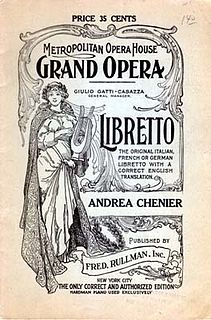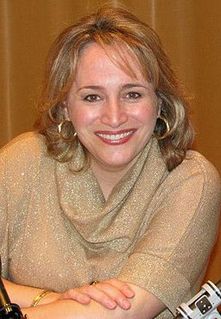Related Research Articles

Don Pasquale is an opera buffa, or comic opera, in three acts by Gaetano Donizetti with an Italian libretto completed largely by Giovanni Ruffini as well as the composer. It was based on a libretto by Angelo Anelli for Stefano Pavesi's opera Ser Marcantonio written in 1810 but, on the published libretto, the author appears as "M.A."

A libretto is the text used in, or intended for, an extended musical work such as an opera, operetta, masque, oratorio, cantata or musical. The term libretto is also sometimes used to refer to the text of major liturgical works, such as the Mass, requiem and sacred cantata, or the story line of a ballet.

The Letter is a 1940 American film noir crime drama directed by William Wyler, and starring Bette Davis, Herbert Marshall and James Stephenson. The screenplay by Howard E. Koch is based on the 1927 play of the same name by W. Somerset Maugham derived from his own short story. The play was first filmed in 1929, by director Jean de Limur. The story was inspired by a real-life scandal involving the wife of the headmaster of a school in Kuala Lumpur who was convicted in a murder trial after shooting dead a male friend in April 1911. She was eventually pardoned.

The Letter is an American pre-Code drama film produced by Paramount Pictures. It was the first full-sound feature shot at Astoria Studios, Queens, New York City. A silent version of the film also was released. It stars the noted stage actress Jeanne Eagels and O.P. Heggie, and it was directed by Jean de Limur. The film was adapted by Garrett Fort from the 1927 play The Letter by W. Somerset Maugham. It tells the story of a married woman who kills her lover out of jealousy and is brought to trial.

Dido and Aeneas is an opera in a prologue and three acts, written by the English Baroque composer Henry Purcell with a libretto by Nahum Tate. The dates of the composition and first performance of the opera are uncertain. It was composed no later than July 1688, and had been performed at Josias Priest's girls' school in London by the end of 1689. Some scholars argue for a date of composition as early as 1683. The story is based on Book IV of Virgil's Aeneid. It recounts the love of Dido, Queen of Carthage, for the Trojan hero Aeneas, and her despair when he abandons her. A monumental work in Baroque opera, Dido and Aeneas is remembered as one of Purcell's foremost theatrical works. It was also Purcell's only true opera, as well as his only all-sung dramatic work. One of the earliest known English operas, it owes much to John Blow's Venus and Adonis, both in structure and in overall effect.

Santa Fe Opera (SFO) is an American opera company, located 7 miles (11 km) north of Santa Fe, New Mexico. After creating the Opera Association of New Mexico in 1956, its founding director, John Crosby, oversaw the building of the first opera house on a newly acquired former guest ranch of 199 acres (0.81 km2).
Paul Moravec is an American composer and a University Professor at Adelphi University on Long Island, New York. Already a prolific composer, he has been described as a "new tonalist." He is best known for his work Tempest Fantasy, which received the 2004 Pulitzer Prize for Music.

Terry Teachout is an American author, critic, biographer, playwright, stage director, and librettist. He is the drama critic of The Wall Street Journal, the critic-at-large of Commentary, and the author of "Sightings," a column about the arts in America that is published biweekly in The Wall Street Journal. He weblogs at About Last Night and has written about the arts for many other magazines and newspapers, including The New York Times and National Review. He is a regular panelist on Three on the Aisle, a bimonthly podcast about theater in America that is hosted by American Theatre magazine.

Intermezzo, Op. 72, is a comic opera in two acts by Richard Strauss to his own German libretto, described as a Bürgerliche Komödie mit sinfonischen Zwischenspielen. It premiered at the Dresden Semperoper on 4 November 1924, with sets that reproduced Strauss' home in Garmisch. The first Vienna performance was in January 1927.
The Tempest is an opera by English composer Thomas Adès with a libretto in English by Meredith Oakes based on the play The Tempest by William Shakespeare.

Platée (Plataea) is an opera in a prologue and three acts by Jean-Philippe Rameau with a libretto by Adrien-Joseph Le Valois d'Orville. Rameau bought the rights to the libretto Platée ou Junon Jalouse by Jacques Autreau (1657–1745) and had d'Orville modify it. The ultimate source of the story is a myth related by the Greek writer Pausanias in his Guide to Greece.
Jonathan Kent CBE is an English theatre director and opera director. He is known as a director/producer alongside Ian McDiarmid at the Almeida Theatre from 1990 to 2002.

Patricia Lynn Racette is an American operatic soprano. A winner of the Richard Tucker Award in 1998, she has been a regular presence at major opera houses internationally. Racette has enjoyed long-term partnerships with the San Francisco Opera, where she has been a regular performer since 1989, and with the Metropolitan Opera, where she has performed since 1995. Also active on the concert stage, Racette has appeared with many of the world's leading orchestras, including the Boston Symphony Orchestra, the Chicago Symphony Orchestra, the San Francisco Symphony, and the London Philharmonic Orchestra. She also received the award for Best Opera Recording for her performance in the Los Angeles Opera's production of The Ghosts of Versailles at the 59th Annual Grammy Awards.

Zaira is a tragedia lirica, or tragic opera in two acts by Vincenzo Bellini set to a libretto by Felice Romani which was based on Voltaire's 1732 play, Zaïre. The story takes place in the time of the Crusades and the opera's plot involves the heroine, Zaira, struggling between her Christian faith and her love for Orosmane, the Muslim Sultan of Jerusalem.

The Letter is a 1927 play by W. Somerset Maugham, dramatised from a short story that first appeared in his 1926 collection The Casuarina Tree. The story was inspired by the real-life Ethel Proudlock case which involved the wife of the headmaster of Victoria Institution in Kuala Lumpur who was convicted in a murder trial after shooting dead a male friend in April 1911. She was eventually pardoned.
Life is a Dream is a three-act opera with music by Lewis Spratlan from an English-language libretto by James Maraniss which was based on the 1635 play Life Is a Dream by Spanish playwright Pedro Calderón de la Barca. It was written in the 1970s, but did not receive a complete stage premiere until 2010.

Dr. Sun Yat-sen is a 2011 Chinese-language western-style opera in three acts by the New York-based American composer Huang Ruo who was born in China and is a graduate of Oberlin College's Conservatory as well as the Juilliard School of Music. The libretto was written by established playwright and translator Candace Mui-ngam Chong. It is her first opera libretto.

Oscar is an American opera in two acts, with music by composer Theodore Morrison and a libretto by Morrison and English opera director John Cox. The opera, Morrison's first, is based on the life of Oscar Wilde, focused on his trial and imprisonment in Reading Gaol. It was a co-commission and co-production between Santa Fe Opera and Opera Philadelphia. This work received its world premiere at the Santa Fe Opera on 27 July 2013. Opera Philadelphia first presented the revised version of the opera on 6 February 2015.
Cold Mountain is an American opera in two acts and an epilogue, with music by Jennifer Higdon and the libretto by Gene Scheer, based on Charles Frazier's 1997 novel of the same name. The opera is a co-commission between Santa Fe Opera, Opera Philadelphia and the Minnesota Opera, in collaboration with North Carolina Opera. The opera received its world premiere at Santa Fe Opera on 1 August 2015. This production coincided with the 150th anniversary of the ending of the American Civil War. Opera Philadelphia gave its first performance of the opera, in a slightly revised form, on 5 February 2016. North Carolina Opera gave the opera its home state premiere on 28 September 2017. Minnesota Opera is staged the opera in 2018 as part of its New Works Initiative. The Virginia Opera will also feature performances of the opera during February 2021 as part of its themed "Love is a Battlefield" 2020-2021 season.
The Shining is an American opera in two acts and an epilogue, with music by composer Paul Moravec and a libretto by Mark Campbell, based on the 1977 novel by Stephen King. The opera received its world premiere on 7 May 2016 at the Ordway Music Theater, Saint Paul, Minnesota. It is part of the "New Works Initiative" of Minnesota Opera.
References
- Mays, Desirée, "The Letter", Opera Unveiled, Vol. 11. Santa Fe: Art Forms Inc., 2009. ISBN 978-0-9707822-7-4
- Maugham, W. Somerset, "The Letter" in Collected Short Stories, Vol. 4. New York: Penguin Books, 1978